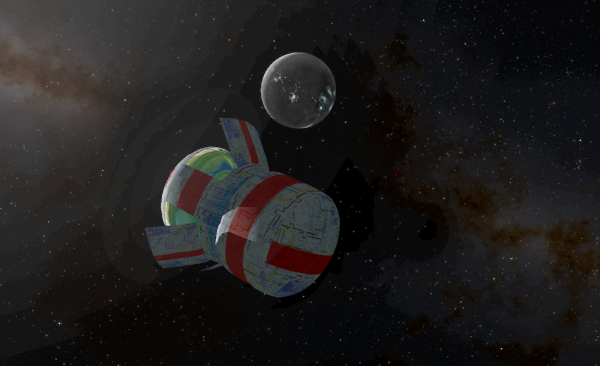BY LETTER
Campbell Station
History > 0030 to 0900 AT: Solsys Era > 130 to 400 AT: The Interplanetary Age
Technology > Application > Infrastructure
Technology > Application > Infrastructure
Solsys Era space habitat | |
 Image from Steve Bowers | |
| Campbell Station, with the lights of Luna's many colonies in the background | |
One of the cylinders, often identified in historical accounts as "Alphabet", was used primarily for habitation, with the sub-surface living areas and "ground level" landscaping while the other cylinder, dubbed "Chicken" in these same accounts, served primarily as a wilderness area and biome buffer. A ring-shaped lake dominated the aft third of this second cylinder, and was purportedly named "Soup" by the inhabitants. Information is scarce on the naming origins of both the cylinders and its regions, but anecdotal evidence suggests the names were some form of humorous nod to some element of then contemporaneous pop-culture.
When originally conceived, the station was intended to follow an Aldrin orbit between the Earth and Mars, but after years of delays in construction and other transportation links coming to dominate the Earth-Mars route by the time it was completed in 304 AT (2273 CE), Campbell Station was relegated to a cislunar orbit and a permanent, rather than a primarily transient, population of 28,000. Although originally intended to be a corporate holding, financial insolvency of its parent company caused the orbital to be seized by the United States government. After arbitration, Campbell Station was incorporated as a municipality in the American state of Excelsior.
Campbell Station appears to have weathered the Technocalypse better than many orbitals in cislunar space, but information from this period is incomplete. During the Great Expulsion, Campbell Station reached more than 300% of its original projected population capacity, as refugees from Earth filled its living space. This was only possible due to extensive life support upgrades, the eradication of nearly all the livestock from both the "Alphabet" and "Chicken" cans, and the settlement of the majority of the displaced persons within the "Chicken" can.
Campbell Station was disassembled at some point during the Interplanetary Dark Age, likely in the 8th Century AT. Outside of its unusual naming, there is little to distinguish this early example of a spin-gravity station from the many other examples which then existed. It was briefly made famous, several millennia after its destruction, when in 3387 AT the transapient known as Aesthetic of Modernity, in a highly publicized bit of what was billed as performance perfect art, donated a full scale model of the station to the Warhol Engineering Institute on Daffy.
Related Articles
Appears in Topics
Development Notes
Text by Sean R
Initially published on 17 July 2020.
Initially published on 17 July 2020.






